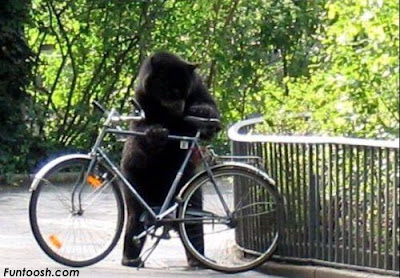Today I could have posted something faux-spooky or silly for Halloween. But, as today is the one-year anniversary of a tragedy that hit close to home, I am going to repeat my post from the day after Halloween:
It could have ended that way--for me, for anybody.
The Argentinians, the Belgian, never suspected that under a clear autumn sky in New York, death would descend upon them. They certainly never expected it to come in the form of a van jumping the barrier that kept all of the other West Street traffic away from them, or for said van to be driven by someone who knew nothing about them except that they were riding bicycles peacefully. On their bikes, they never expected to meet the fate of the folks sipping drinks at Le Carillon or listening to music at the Bataclan. Or the ones enjoying a fireworks display on Bastille Day or shopping in a Christmas marketplace. Or simply out on a summer day.
No one expects it to end that way.
Of those five Argentinians and the Belgian who went for a bike ride--and two others who went for a walk--on the West Side Bike Path, all that remain are mangled bicycles and shards of clothing and other personal items. They went for a stroll, they went for a ride, and each of them is gone, gone, gone.
It could have been me.
I can only be grateful that it wasn't. My thoughts are with the victims.
It could have been me.
I could not get that phrase out of my mind as I rode to work this morning.
It could have been me.
Today dawned bright and clear for me, as it did for them--yesterday. A beautiful mid-autumn day, sunny, a little chilly but not unpleasantly so, with strong breezes shaking leaves turned red and yellow from their branches and rippling reflections of the sky, glass, steel and concrete at the mouth of the Hudson.
In other words, the sort of day people picture in their fantasies about bike-riding in New York.
It could have been me.
And so they went for a ride, for fun. I was riding, too, in an entirely different part of town, from my job back to my apartment. Though they weren't going to work, many others who followed their path, on bike or on foot, no doubt were. I myself have ridden along that path, to work and for the same pleasures they were enjoying.
I could have been one of them.
Five came from Argentina--old friends celebrating the 30th anniversary of their graduation from their high school. Another came from Belgium, with her mother and sister. They survived because they weren't with her.
I could have been her.
So could any of the kids who were leaving Stuyvesant High School at that very moment. No doubt some of them sauntered along, or pushed or shoved each other (as high school kids are wont to do) into or along the path. They would hang out with other kids. Or they would go to practices in sports they play, languages they are learning, plays in which they are performing or skills for tests they will take and essays they will write in the hopes of getting into the colleges they or their parents choose. One assumes that one day, at least some of them will be part of some 30th anniversary celebration, wherever in the world they may be.
They could have been among them.
Still others walked dogs, pushed strollers and held hands as they strolled along the nearby piers. Or they sluiced through crowds on skates and skateboards. They were all mere blocks away from the 9/11 Memorial and even closer to--though, as fate would have it, a world apart from--the Argentinian and Belgian tourists on bicycles.
I could have been with them.
For a time in my life, I was riding daily along the stretch of the Manhattan Greenway known officially as the Hudson River Greenway-- or more commonly as the West Side Highway Bike Path-- along the stretch that separates Greenwich Village, SoHo and Tribeca from the river. At that time, it was part of my route to work. Before and since then, I have ridden there for pleasure--sometimes as part of a city jaunt, as the tourists did yesterday; other times en route to a ferry or bridge that would take me to another part of my ride. More often than not, I rode alone, but sometimes I'd accompany whomever I happened to meet--along the way to my job or wherever else I happened to go.
They could have been with me.
Every time I pedaled along that path, I was home within a few hours. Today I will be home about 40 minutes after I leave work and get on my bike. They, I am sure, thought they were going home, too--today, tomorrow, next week or the week after.
I could have gone with them.
But they are not going home. They probably never even imagined that they wouldn't: They could not have foreseen the way their rides, their vacations, their journeys, would end.
I could not get that phrase out of my mind as I rode to work this morning.
It could have been me.
Today dawned bright and clear for me, as it did for them--yesterday. A beautiful mid-autumn day, sunny, a little chilly but not unpleasantly so, with strong breezes shaking leaves turned red and yellow from their branches and rippling reflections of the sky, glass, steel and concrete at the mouth of the Hudson.
In other words, the sort of day people picture in their fantasies about bike-riding in New York.
It could have been me.
And so they went for a ride, for fun. I was riding, too, in an entirely different part of town, from my job back to my apartment. Though they weren't going to work, many others who followed their path, on bike or on foot, no doubt were. I myself have ridden along that path, to work and for the same pleasures they were enjoying.
I could have been one of them.
Five came from Argentina--old friends celebrating the 30th anniversary of their graduation from their high school. Another came from Belgium, with her mother and sister. They survived because they weren't with her.
I could have been her.
So could any of the kids who were leaving Stuyvesant High School at that very moment. No doubt some of them sauntered along, or pushed or shoved each other (as high school kids are wont to do) into or along the path. They would hang out with other kids. Or they would go to practices in sports they play, languages they are learning, plays in which they are performing or skills for tests they will take and essays they will write in the hopes of getting into the colleges they or their parents choose. One assumes that one day, at least some of them will be part of some 30th anniversary celebration, wherever in the world they may be.
They could have been among them.
Still others walked dogs, pushed strollers and held hands as they strolled along the nearby piers. Or they sluiced through crowds on skates and skateboards. They were all mere blocks away from the 9/11 Memorial and even closer to--though, as fate would have it, a world apart from--the Argentinian and Belgian tourists on bicycles.
I could have been with them.
For a time in my life, I was riding daily along the stretch of the Manhattan Greenway known officially as the Hudson River Greenway-- or more commonly as the West Side Highway Bike Path-- along the stretch that separates Greenwich Village, SoHo and Tribeca from the river. At that time, it was part of my route to work. Before and since then, I have ridden there for pleasure--sometimes as part of a city jaunt, as the tourists did yesterday; other times en route to a ferry or bridge that would take me to another part of my ride. More often than not, I rode alone, but sometimes I'd accompany whomever I happened to meet--along the way to my job or wherever else I happened to go.
They could have been with me.
Every time I pedaled along that path, I was home within a few hours. Today I will be home about 40 minutes after I leave work and get on my bike. They, I am sure, thought they were going home, too--today, tomorrow, next week or the week after.
I could have gone with them.
But they are not going home. They probably never even imagined that they wouldn't: They could not have foreseen the way their rides, their vacations, their journeys, would end.
It could have ended that way--for me, for anybody.
The Argentinians, the Belgian, never suspected that under a clear autumn sky in New York, death would descend upon them. They certainly never expected it to come in the form of a van jumping the barrier that kept all of the other West Street traffic away from them, or for said van to be driven by someone who knew nothing about them except that they were riding bicycles peacefully. On their bikes, they never expected to meet the fate of the folks sipping drinks at Le Carillon or listening to music at the Bataclan. Or the ones enjoying a fireworks display on Bastille Day or shopping in a Christmas marketplace. Or simply out on a summer day.
No one expects it to end that way.
Of those five Argentinians and the Belgian who went for a bike ride--and two others who went for a walk--on the West Side Bike Path, all that remain are mangled bicycles and shards of clothing and other personal items. They went for a stroll, they went for a ride, and each of them is gone, gone, gone.
It could have been me.
I can only be grateful that it wasn't. My thoughts are with the victims.
































